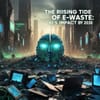A recent study highlights a concerning trend: artificial intelligence could generate millions of tons of electronic waste by 2030. As AI technologies become increasingly integrated into everyday life, the potential for electronic waste associated with these advancements is raising alarms among researchers and environmental advocates.
The rapid growth of AI applications means that devices and systems are evolving quickly, often leading to shorter lifespans for electronic products. Many of these devices, once outdated, contribute to the growing pile of e-waste, which poses significant challenges for waste management and environmental sustainability.
Experts emphasize the need for proactive measures to address this looming issue. This includes designing electronics with longevity in mind, promoting recycling programs, and encouraging consumers to make informed choices about their tech purchases. Developing a circular economy for electronic devices can help mitigate the impact of e-waste while maximizing resource efficiency.
Additionally, the study calls for greater collaboration between tech companies, governments, and environmental organizations. By working together, stakeholders can create strategies that minimize waste and promote responsible consumption and disposal practices.
AI continues to transform our world, addressing the environmental implications of this technology is crucial. Ensuring that progress in artificial intelligence does not come at the expense of our planet will require collective action and a commitment to sustainable practices.


